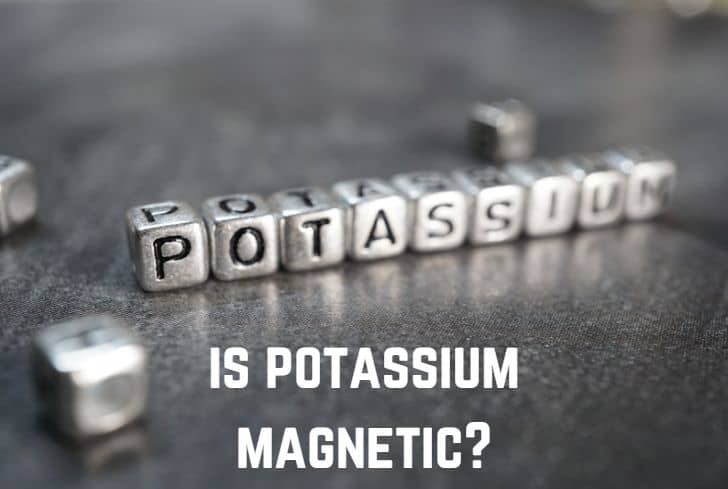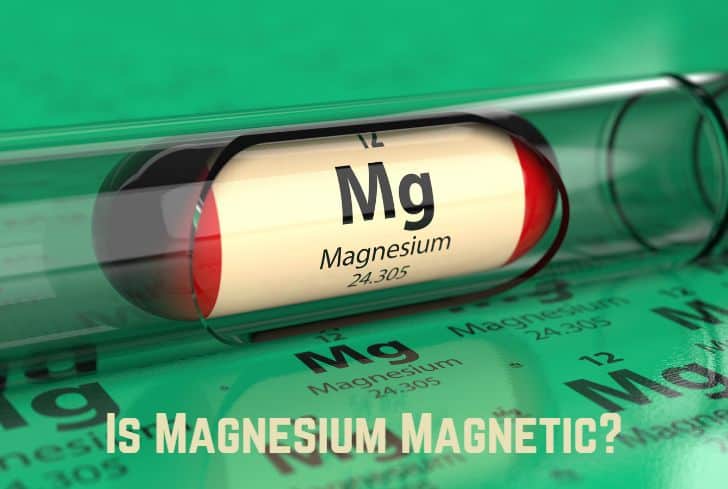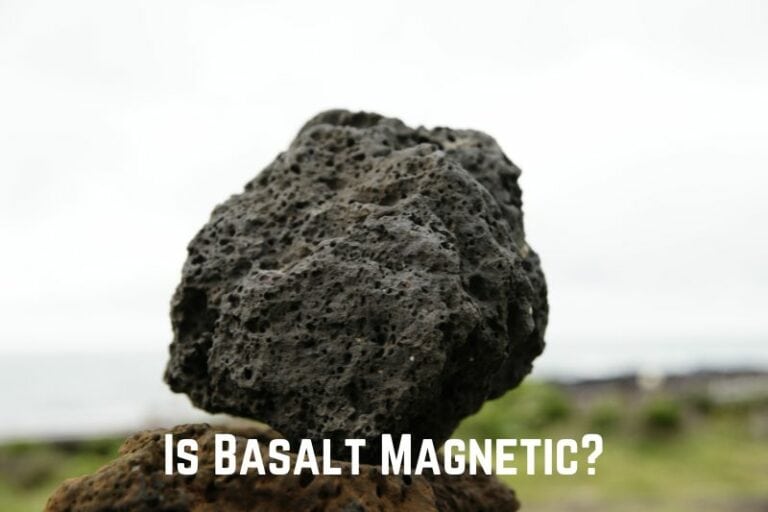Is Potassium Magnetic? (Answered)

Potassium (K) is a chemical element with the atomic number 19. It is a soft, silvery-white metal that can be cut with a knife. It reacts rapidly with oxygen to form flaky white potassium peroxide. Potassium also reacts with water and creates sufficient heat to burn with a lilac-colored flame.
Potassium derives its name from the term “potash”, which refers to an old method of extracting the mineral: placing the ash of plants (wood, leaves, etc.) in a pot with water and then evaporating the solution.
Have you ever wondered if potassium is magnetic? In this article, we are going to discuss just that. We will begin with the properties and uses of potassium. Then we will talk about its magnetism. We will also discuss other compounds of potassium and their magnetism.
Read: Is Graphite Magnetic?
Is Potassium a Magnetic Material?
Potassium, being a metal, can show some degree of magnetism. However, it is not as magnetic as other metals like iron. It has one unpaired electron in its outer shell and is weakly attracted to magnets.
Let us first learn what magnetism is. Magnetism is a force caused by the motion of electric charges. Every substance is made up of atoms. These atoms have electrons (particles that carry an electric charge) that circle the atom’s center, called the nucleus.
In most substances, equal numbers of electrons spin in opposite directions. This cancels out their magnetism, and they are not attracted by a magnetic field. These include things like cloth, wood, paper, etc., and are called diamagnetic.
However, in some substances like iron, the electrons spin in the same direction. This allows their magnetic fields to combine, and it produces a magnetic field extending beyond the atoms. These objects are strongly attracted to magnets and are called ferromagnetic.
So, the magnetism of an element depends on the number of unpaired electrons it has. In potassium, the electron configuration is 1s22s22p63s23p64s1 or [Ar]4s1. This means that potassium has only one unpaired electron.
So, potassium is a weakly magnetic material. Its compounds, however, can be diamagnetic or paramagnetic, as we will discuss later.
Properties of Potassium
These are the properties of potassium:
- Physical: Potassium is a silvery white metal. However, it quickly oxidizes in the air to produce a dull gray surface layer (potassium peroxide). Potassium has a metallic luster and is highly reflective, which is why it is used in mirrors and fireworks.
- Chemical: Potassium has the atomic number 19. It belongs to the alkali metal group and has only one valence electron, which makes it highly reactive. Due to its high reactivity, it is never found in its elemental state in nature but has to be extracted from minerals.
- Thermal Properties: Potassium has a relatively low melting point of 63.38 °C (145.08 °F) and a boiling point of 759 °C (1,398 °F). It is a good conductor of heat as its metal lattice allows the movement of electrons (and therefore heat). Potassium also has a high coefficient of heat expansion, which is why it is used in the production of glass.
- Density & Hardness: Potassium has a relatively low density of 0.86 g/cm3. This is because its atomic size is large and the valence electron is weakly attracted to the nucleus. It is incredibly soft, having a value of 0.5 on the Mohs Hardness Scale. Therefore, it can easily be cut with a knife and scratched easily.
- Biological Role: Potassium is a vital element for living beings and is needed for essential physiological processes such as nerve function, muscle contraction, etc. Around 140 grams of potassium exist in the human body, mostly present in the intercellular fluid. Potassium deficiency can cause serious health issues.
Uses of Potassium
These are the uses of potassium:
- Fertilizer: Potassium is an essential plant nutrient and is used as a fertilizer in agriculture, horticulture, and hydroponic culture (growing plants without soil). They represent the “K” in the “NPK” fertilizer label used globally. 95% of potassium produced globally goes into agricultural fertilizers, mostly in the form of chlorides.
- Food Additive: In many kinds of baking powder, potassium sodium tartrate is the key component. Potassium bromate is used in dough making, as it is an oxidizer and improves the dough’s strength & height. Potassium bisulfite helps in beer and winemaking.
- Industrial Use: Potassium hydroxide is a strong base that is used to neutralize acids, control pH, and manufacture potassium salts. It is also used in the saponification of fats and oils as well as in hydrolysis reactions. Potassium chromate is employed in the production of inks, safety matches, fireworks, etc.
- Medical Treatments: Potassium has various medical uses. Potassium citrate is used in kidney stone conditions. Potassium chloride is used to treat low blood potassium, which is caused by vomiting, diarrhea, or other health problems.
- Other Uses: Potassium has a variety of niche uses. For example, potassium superoxide acts as a portable source of oxygen and a carbon dioxide absorber, which is why it is used for respiration systems (in mines, submarines, etc.). The alloy of sodium and potassium is used in laboratories to produce dry and air-free solvents.
Is Potassium Nitrate Magnetic?
No, potassium nitrate is not significantly magnetic. It is a salt made up of potassium (K+) and nitrate ions (NO3-) ions, having the formula KNO3. It can show slight magnetism in magnetic fields but it would be quite weak.
Potassium nitrate is a white crystalline solid. It is an alkali metal nitrate salt that is also known as Indian saltpeter since it was historically mined in India. In nature, it occurs as the mineral niter and is the source of nitrogen (which gets its name from the mineral).
Potassium nitrate is used in fertilizers, rocket propellants, and fireworks. It is a key component of gunpowder. Potassium nitrate is also used as a food preservative (especially for meat) and also in toothpaste.
Potassium nitrate does not exhibit any significant magnetism. The little magnetic effect it exhibits in the presence of magnetic fields cannot be used for any practical purpose.
Is Potassium Feldspar Magnetic?
Potassium feldspar is not generally considered to be magnetic. It does not contain magnetic elements like iron or nickel. However, the presence of some impurities can make it weakly magnetic.
Potassium feldspar refers to several minerals in the feldspar family that contain potassium. It includes orthoclase (a tectosilicate mineral forming igneous rocks), sanidine (a high-temperature form), Amazonite (a green type of microcline), etc.
Orthoclase has a chemical formula of KAlSi3O8, and it consists of potassium, aluminum, silicon, and oxygen atoms, which are arranged in a three-dimensional structure. It is typically found in igneous rocks such as granite. Orthoclase is used in the manufacture of ceramics, glass, and other industrial products.
Potassium feldspar is not magnetic in itself. However, since it is an amalgam of minerals, it can sometimes include metals (such as iron or nickel) that are magnetic. These can make the feldspar weakly magnetic.
Is Potassium Radioactive?
No, potassium itself is not radioactive. However, there is one naturally occurring potassium isotope (40K) that is radioactive. This isotope is present in all potassium-containing minerals and is also found in the human body.
The amount of 40K in a random potassium sample is usually quite small, and the radiation emitted by this isotope does not pose any health risk. Potassium is an essential nutrient for health and is found in many food items like fruits, vegetables, means, etc.
However, higher levels of exposure to 40K radiation can be harmful and can increase the risk of health problems like cancer.
Is Potassium Malleable?
No, potassium is not generally malleable. It is a soft mineral that can be easily cut with a knife. Because of its high reactivity to air and water, it cannot be used as a structural material; instead, it is used for industrial purposes.
Malleability refers to the ability of a material to be beaten into thin sheets or other shapes without cracking or breaking. Gold, copper, and aluminum are metals that are quite malleable, so they can be used to make wires, foils, and other materials.
Potassium, however, is not malleable. It is an extremely soft mineral that can even be cut with a knife. It is highly reactive, and when exposed to fire, it can instantly catch fire. It usually has to be stored under oil to prevent it from reacting.
It can become more malleable and ductile at higher temperatures, and can then be shaped through processes like extrusion and forging. However, it would not be of much use; its high reactivity would create safety hazards, so it cannot be used as a structural material.
Instead, potassium is used for industrial purposes, such as a catalyst in chemical reactions, an alloying element in some metals, etc.
Read: Is Granite Magnetic?
Conclusion
In this article, we have discussed the magnetism of potassium. We began by looking at the properties and uses of potassium. Then we talked about its magnetic properties: it is not generally attracted to magnets although some of its compounds can be weakly magnetic. Finally, we looked at potassium’s radioactivity and malleability.

![Is Chapstick Flammable? [Lip Balm, Lipstick, Lip Gloss]](https://eartheclipse.com/wp-content/uploads/2023/03/is-chapstick-flammable.jpg)




